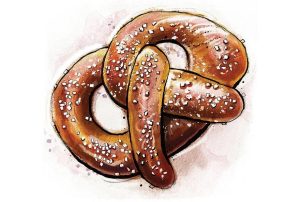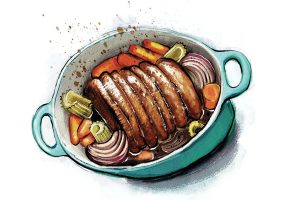The name ‘toad in the hole’ suggests something a little more whimsical (or saucy) than its reality. The origins of the name are spurious and, to be honest, a little tenuous: I’ve seen theories that the hole is a hungry stomach and the toad a ‘substantial meal’, another that suggests the dish resembles the way toads peep their heads out of burrows, and another which attributes the name to a trend in the 18th century for live toads to be encased in stone. I confess, I don’t find any of these hugely convincing,
In its earliest incarnation it was simply referred to as ‘meat boiled in a crust’ (a strong contender for ‘least appealing name for a dish’, but then, so is ‘toad-in-the-hole’); in Hannah Glasse’s 1900 cookbook, there was a recipe for ‘Pigeons in a hole’ but, to be fair to her, at least actual pigeons were baked into the batter. Happily, it seems clear that no toads ever appear to have been harmed in the making of toad in the hole.
For the uninitiated — and let’s be honest, the name doesn’t provide any clues — toad in the hole is sausages baked in a Yorkshire pudding: it’s generally cooked as a large dish designed to be served family-style, rather than individual puddings. This wasn’t always the case: although the name toad in the hole appeared as early as the mid-18th century, it was a slightly different dish to the one we know today: batter puddings were initially designed to make scraps or small amounts of meat go further, bathing them in cheap, pillowy batter, and early recipes used leftovers or stewed meats; Mrs Beeton’s recipe used beef steak and lamb’s kidney.
We assume that the toad in this situation is the sausage, and the hole the batter — a position supported by Sue Townsend’s Adrian Mole, who reports that his friend Nigel was thrown out of school dinners for swearing at the toad-in-the-hole declaring it ‘All bleeding hole and no toad’.’ To be fair to Nigel, a good distribution of sausage and batter is integral to the enjoyment of the dish, and perhaps a ratio that is contentious when the aim of the dish has historically been making leftovers go further.
Either way, for most of us, batter puddings have narrowed down to those containing sausages. So, the components of a toad in the hole are now both few and fairly consistent: sausages, batter and fat.
I am not a fussy eater, but I do have traumatic memories of ghostly pale sausages served up to me at a friend’s house when I was a child, so slippery and slimy as to be inedible. So, for me, browning the sausages before they join the batter is non-negotiable; giving the sausages a good roast in the oven first ensures that they are bronzed and taut rather than pallid and floppy.
You can use any sausage you fancy in a toad in the hole, even Cumberland if your heart so desires (do it in a big, round roasting tin for something quite spectacular)— personally, I particularly like Lincolnshire sausages, which are flavored with sage, and pair particularly nicely with beer batter and onion gravy. I’ve written before of my love for onion gravy, so I’d be quite happy to serve a jug of it up even if it weren’t strictly necessary, but the one thing that toad in the hole doesn’t have going for it is its own sauce. Onion gravy is, therefore, obligatory.
Good batter will inflate and crisp in the oven, billowing upwards, slightly encasing the sausages.
Using a combination of milk and beer hits the sweet spot of flavor and lift. Leaving the batter to rest — as you should with Yorkshires or pancakes — lets the gluten relax and the starch grains a chance to swell, both of which should result in a lighter, fluffier pudding. You can roast the sausages while the batter is resting, should you wish, but equally the batter will sit quite happily in the fridge for 24 hours before you use it.
I’m fairly old school, so I like to use lard as the hot fat into which I pour my batter — lard should yield a very crisp batter that, once cooked, comes away from the side of the dish easily, making it easy to portion, but if you are lard averse, you can simply use oil with a high smoking point (rapeseed or sunflower). The key is to ensure that whichever fat you choose to use, you heat it until it’s screamingly hot before adding the batter.

[special_offer]
Toad in the hole with Onion Gravy
Makes: Enough for four
Takes: 10 minutes, plus resting
Bakes: 1 hour
For the toad-in-the-hole
8 sausages
2 eggs
100g plain flour
½ cup milk
½ cup beer
1 tablespoon english mustard
½ teaspoon salt
25g lard (or 2 tablespoons sunflower oil)
For the onion gravy
1 small red onion, sliced
1 tablespoon sunflower oil
1 tablespoon plain flour
2 cups beef stock
- First, beat the eggs with a whisk until they are noticeably thicker and paler than before. Add the flour, followed by the milk and beer whisking gently to incorporate until there are no lumps. Stir in the mustard and salt. Cover and leave the batter to rest for 30 minutes in the fridge
- Preheat your oven to 390°F and place the sausages in a small baking tray. Roast the sausages for 30 minutes, shuffling them half way through to help them brown evenly
- Once cooked, set the sausages to one side and turn the oven up to 430°F. Put the lard (or oil) into a baking dish just a little larger than the sausages lined up together, and put that baking dish in the oven. Heat until the fat is very hot: the lard will have melted and will likely be sizzling and smoking a little
- Carefully pour the batter into the heated baking dish — the hot oil can spit if you’re too enthusiastic. Gently put the sausages into the batter, spacing them roughly evenly. Put the whole thing in the oven for 30 minutes
- Meanwhile, make the onion gravy: heat the oil in a pan over a low heat. Add the sliced onions and cook until soft, but not browned. Add the flour and stir it into the onions, cooking for a couple of minutes until the flour sizzles. Pour in the stock a little at a time, stirring to incorporate the flour and beat out any lumps. Once all the stock is incorporated, leave the gravy to bubble until it is thick and glossy, stirring occasionally
- Once the batter has had its 30 minutes, the toad in the hole should be inflated and golden, encasing the mahogany sausages
This article was originally published onSpectator Life
.


















